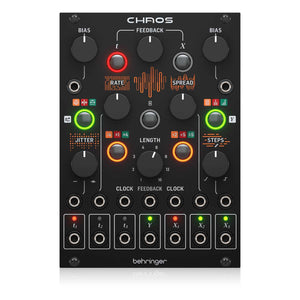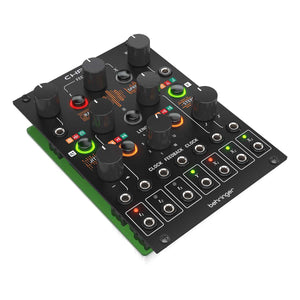Your Cart is Empty


Create intricate melodies as well as complex beats and soundscapes with the Behringer CHAOS, an analogue Eurorack module capable of random sampling. Control clock speeds, trigger and CV probability, scale length for some over-the-top melodies, ambient washes, and grooves in an infinitely tweakable module. When talking about the CHAOS it’s best to break it down into two parts, the t section, and the X section. The t section generates gates at random that are tied to a master clock. The X section generates three random voltages which are clocked to the t section. Each section is infinitely tweakable and can be patched to different sources to create some truly unique sequences. Within the t section, there are three main outputs: t1, t2 and t3. A master clock is generated out of t2. You can “warp” this clock by turning the Jitter knob clockwise or counter clockwise. This simulates the minor imperfections a musician may have when playing to a metronome to give your beats a more natural feel.
Features
-
Amazing powerhouse to create random rhythm and musical ideas
-
Sound engines based on Mutable Instruments * Marbles
-
t generator creates a ”warped“ clock source by simulating the missteps of a musician trying to play to a click
-
X generator provides 3 random CV sources, clocked by the t generator
-
Memory function recalls the order of each preceding clock abberration, voltage or rhythm
-
2 separate audio outs for both the main sound and a dynamic variant
-
Eurorack specs: 16 HP, 70 mA +12 V, 40 mA -12 V
The t section of the CHAOS features three modes. In the green mode, a coin is tossed at each pulse of t2 which determines if the output passed to t1 or t3. The orange mode multiplies and divides t1 and t3 respectively by a random ratio. Lastly, the red mode alternates between t1 and t3. Within these three modes, you can control how often t1 or t3 is triggered, multiplied, and divided by turning the Bias knob left or right. Similar to the t section, the X section also features three outputs, X1, X2 and X3 which can be triggered from any of the outputs in the t section or other external sources like the Behringer BRAINS. The voltage output can be manipulated with the Step control. Turning this knob counter clockwise smooths out the voltage steps while turning the knob clockwise sets the voltages to bounce around a scale from chromatic, major, major thirds and all the way down to octaves.


